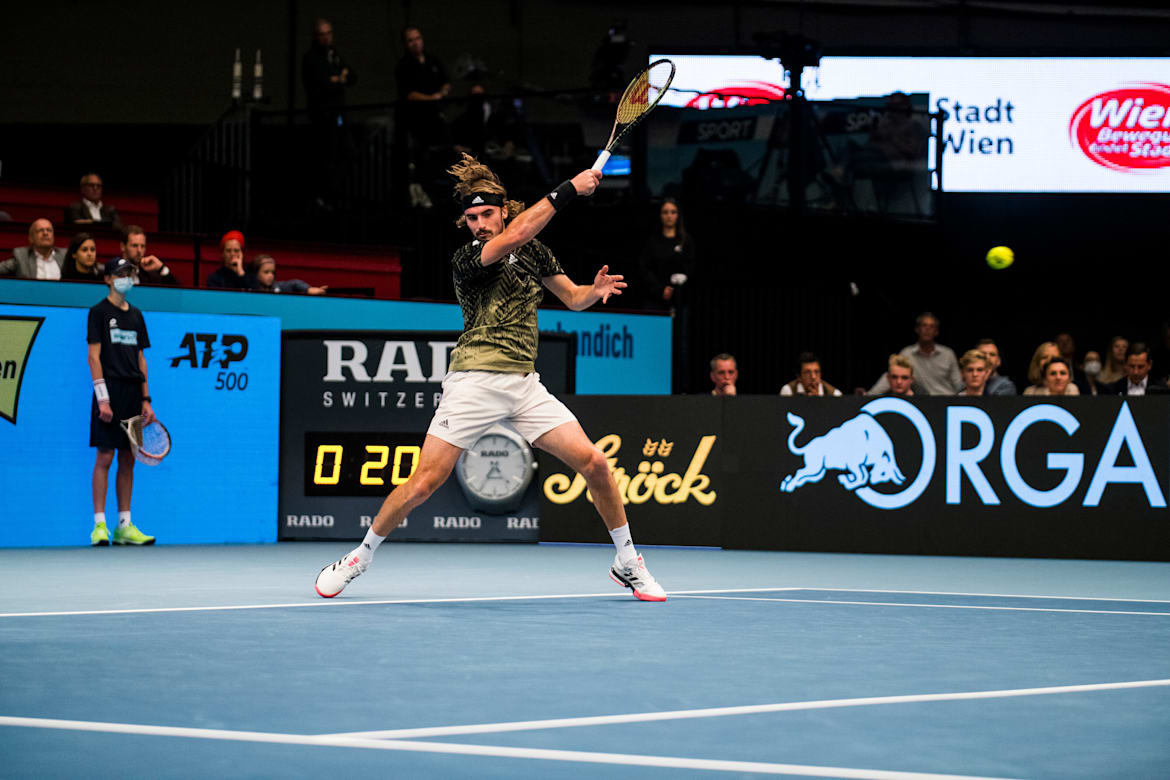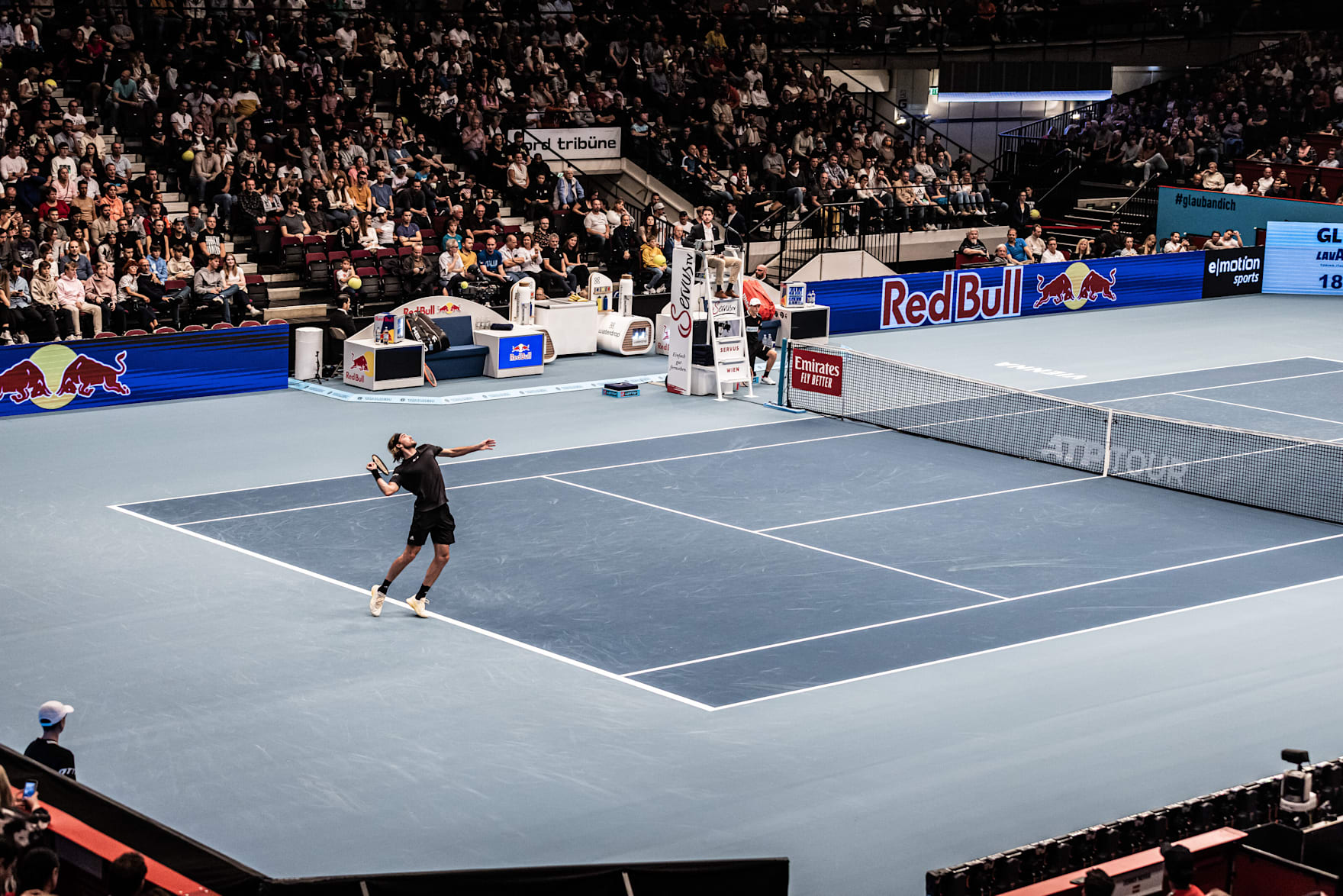Greek ace Stefanos Tsitsipas talks about the parts of his game that will prove vital when playing the latter stages of Grand Slams.
The Grand Slam series of iconic tennis tournaments is well underway and Stefanos Tsitsipas is once again catching the eye. Most recently, the world number five has come through absorbing five-set matches against former US Open champions Dominic Thiem and Andy Murray at the Wimbledon championship in London.
For Tsitsipas, excelling on the famous grass courts at SW19 requires numerous aspects of his game to be firing. Here, the two-time Grand Slam finalist discusses the three most important factors that can make a difference when searching for success.
01
Covering the court
Standing at 1.93m tall and displaying a stride as powerful as it is smooth, Tsitsipas has the ability to cover all areas of the court. “This is an essential asset in tennis, because it allows players to effectively reach and return shots from all areas of the court,” explains the Greek star.

Ensuring he moves well and covers the court is vital for Tsitsipas as it allows him to dictate rallies and hit the ball from an optimal position, allowing him to impart spin, find unpredictable angles and vary his power.
“This is why I have to surround myself with a great technical team which includes my fitness trainer, my coach and my physio,” he explains. “Having a deep understanding of the game and my opponent’s tendencies is crucial for perfect court coverage. Prior to any match my coach and I always study the opponent’s pattern so that I can try and anticipate the next move.”
02
Striving for the perfect forehand
The forehand is one of the signature shots of Tsitsipas and one of the most devastating weapons in his vast repertoire of strokes. One of the keys to this thundering stroke is his grip. “My grip is quite ‘flat,’ as we say in tennis, but I am still able to generate power and topspin while maintaining control.”
Finding the right balance between consistency and power with the forehand is crucial, especially on a fast surface like the grass at Wimbledon. And that’s why Tsitsipas has to be adaptable. “During rallies, I generally stick to my preferred grip, but minor adjustments can be made depending on the situation and the type of shot I want to execute,” he adds.

Throughout the years of practice I have developed such a strong and, as you say, elegant forehand.
As competition intensifies and the need to hit more accurately increases, Tsitsipas is seeking that ideal forehand. The one that, in his words, “combines power, accuracy and spin and involves good footwork, positioning and timing.”
“My favorite forehand is the inside-out forehand, which I follow up at the net, searching for the volley depending on the situation.” When asked if he can identify the perfect forehand just by its sound, his response doesn’t indicate doubt. “Yes, absolutely. A sweet sound and an even sweeter feel. Clean and crisp.”
That clean and crisp forehand isn’t coincidental, but rather the result of a long-term process that involves constantly refining a technique that many believe is one of the smoothest and most elegant on tour. “My goal is to have a good contact point and throughout the years of practice I have developed such a strong and, as you say, elegant forehand, which I am humbled by.”
03
Serving for the win
The serve is arguably the most important facet of anyone’s game. It can help establish an advantage over an opponent and can earn quick points whether with an ace or an unreturnable serve.
For Tsitsipas, the correct serving technique starts with the fundamentals. “When serving, my rhythm is very important but the most important part is the toss. If I’m able to repeatedly get a good toss, then I’ll most likely hit a good serve and hope for the elegance.”
That elegance was dominantly displayed in Madrid a few weeks ago when he played against Thiem and achieved an incredible figure: 39 successful first serves in a row.
“I have to say that during the match I wasn’t aware of how many first serves I’d made, but now, looking back at it, I can remember feeling very zen and focused, some call it flow. Once in this mental state, everything slows down and all you can see is the ball. I strive for this every match,” he says.
Tsitsipas emphasizes the mental component of the serve, which is the only type of shot in which a player has a relatively large window of time to decide prior to executing it. In his case, this preliminary thought process encompasses several factors.
“How and where to serve will depend on several factors. Some being who I’m playing against, what surface I’m on, what the weather’s like, but mainly how I’m feeling on that day,” he explains.
“On grass, the serve remains crucial, but other factors such as movement and adaptability also come into play. Grass courts can be faster, making it more challenging to defend against powerful serves.”

Footwork, for some perhaps the most important physical and technical element of tennis, also becomes especially relevant on the Wimbledon grass. “Players who can adjust their footwork and quickly adapt their game to the lower bounce and slick surface can gain an advantage. So, while the serve remains important, the all-around game becomes vital on grass.”
“Obviously, I’m a fan of serve and volley, so therefore I would like to keep working on that part of my game.”
Tsitsipas seems well prepared for the challenges that the rest of the season will bring. The Greek star is still looking to win his first title this year, though he did reach the final of the Australian Open. If he’s to once again go deep in a Slam, then footwork and mobility will be crucial. But it is his fierce court coverage, powerful forehand and consistent serve that could hold the key to success.
